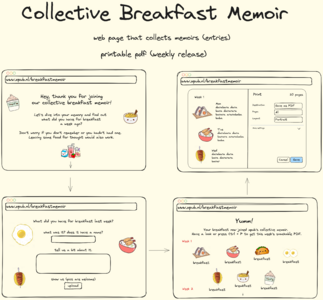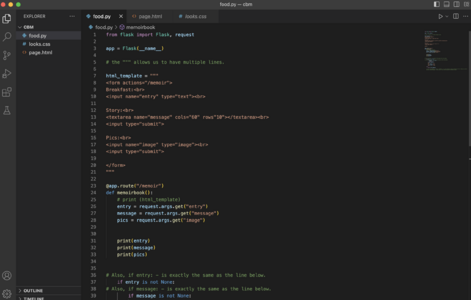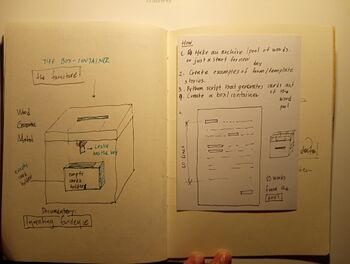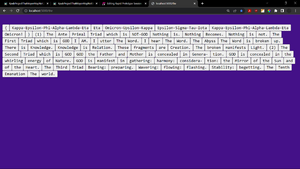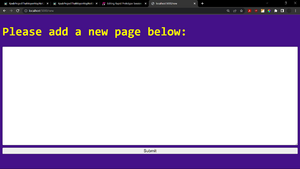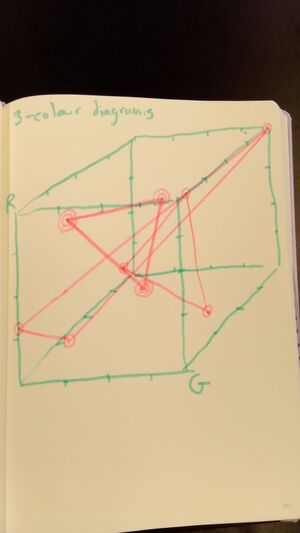Rapid Prototype Session 2: Difference between revisions
No edit summary |
|||
| Line 185: | Line 185: | ||
The box will be metal, wooden or ceramic. It will have a lock (Leslie will have the keys) and a slot to place the story form. From the outside there is a holder for the blank forms. | The box will be metal, wooden or ceramic. It will have a lock (Leslie will have the keys) and a slot to place the story form. From the outside there is a holder for the blank forms. | ||
Revision as of 09:45, 1 June 2023
Future projects that MAY or MAY NOT be made
Today's pad: https://pad.xpub.nl/p/XpubProjectThatMayorMayNot
Pad from last Methods session: https://pad.xpub.nl/p/RPG23
Outcome:
1) Brief text outlining a future project that MAY or MAY NOT be made and
2) three entries to the RPD .
11:00-13:00
Following introduction by Steve and a discussion about current state of play with the Special Issue:
11:15
In 4 groups of 1
Outline a project you would like to make.
What will it be? (Three sentences max)
Why do you want to make it? (Three sentences max)
Describe how it would be made: describe the stages needed to make it (Four sentences max)
Make a timetable for the project
12:30 Give feedback on each other's outlines (meet as one group)
Note: please make the outline as practical as possible; please avoid specialist terms and theoretical terms.
13:00
LUNCH
14:00- 16:00
Make three new entries to the RPD (30 mins for each). Allow these “rapid prototypes” to make a gesture in the direction of your outline for a future project that MAY OR MAY NOT GET MADE (they could be drawings, brief script, photos, mock ups, maquettes, collage, code &c).
16:00
Upload text and Rapid prototypes onto this page. Group reviews future project that MAY or MAY NOT be made in one group.
Xpub
Boyana
What?
Collective Breakfast Memoir: a (snackable) publication about breakfasts people had in the last week. Why do you want to make it? (Three sentences max)
Why Make it?
To work with memory as a tool that evokes memories of taste and/or instances of conversations around food people (participants) had recently.
Workflow
Simple web page where participants can make an entry of their weekly breakfasts (in case they hadn't had breakfast they'd be invited to share some food for thought). Paged.js will help us turn all web entries into a printable publication.
Timetable
1 day build the website:
- html structure - flask? form for input (text, (+ optional) images) - css, style the webpage - paged.js, turn web content into printable pdf
1h share the website with people and invite them to join 1 week collect stories 1h design book cover? 2h print the publication 2-3h share + send the printed publications to participants (and not only) turn it into weekly release?
Rapid prototypes
Boyana # 2
What?
Audio piece made by a group of people.
1. Imagine yourself (or your entire body) as a walking auditory organ, like a human ear, that examines the sound of silence. The "ear' listens to the surrounding environment. The ear is deaf to noise and can only hear (resonate with) silent situations, whatever that could be.
2. Record an audio piece that is a collection of various sounds
3. recorded or sent by me and other participants
4. I write a short poem (haiku, or 3-5 lines at max) that describes the soundscape depicted in the audio piece.
Why make it?
I am often inspired by listening. The project is about the act of improvising; I wanted to combine sound and poetry. Presents a method for sound mixing and writing. It is an Invitation for people to join and collaborate on this silent exploration of our daily situations. The act of improvising, the act of composing poetry or music extemporaneously.
Workflow
1: Write an invitation for participation and invite people to join by distributing it both print & web.
2: Spend some time recording sounds and collecting sounds from others.
3: Save and listen to all sounds and think of was to combine all of them into one.
4: Once we have the audio piece then we can write a short poem about it. What feelings, scenery and/or emotions it evokes in us? A moment of reflection, turning sounds into words.
Timetable
30 min writing the invitation and giving people the option to receive the sound + audio piece if they want
1h printing/distributing the invitation
1 week collecting sounds
1 day listening to all sounds
2-3 hours curating and combining all sounds into one piece
1 hour writing a short poem about it
Rapid Prototypes
Aglaia
Title: It doesn’t have to be good but to exist
What is it? Elements= Forced Memory Cards ( a5) which contains lines on which to write memories and prompts for the user, memory locked box (Leslie will be the key holder), the members and tutors of Xpub1.
Procedure:
1. Fill in the memory form.
2. Deposit memory form in the box (like a locked polling box with a slit at the top)
3. At an agreed date (in one year; in one month; one week later) the box is opened and a publication is made from the collection of memories (forced story forms).
It will be a forced memory box with a lock with a stack of potential story cards. The cards will be small a5 bureaucratic) forms with words out of a pool. At the end of each day, we will have to fill the form my writing a story and put it back to the box. A forced everyday ritual. These forms will create a book/map at the very end
Why make it?
An attempt to find ways to document/archive ourselves together, to find ways to remember together, to find meaning or not together, to understand, reclaim, unlearn, access archival forms or structures.
Workflow
1.make an archive/pool of words from the pads we have used so far = these are prompts for the user to be written the cards; each card has different words (but the structure of the form remains the same) See 3.
2. create examples of form/template
3. python script that generates cards out of the word pool
4.create the box/containner with a locker
5. at the very end create the book/map out of the stories/forms. To be distributed.
Timetable
x hr archive of words sourced by pad – small python script
y hr create the python script for the template
z hr prototype of 2-3 story forms/templates
w hr prototype of the container/box
The word pool/an archive of words:
the pool will be created by the words that we used in the pads this year. I (with manetta or/and joseph) will try to make a script that pulls all the words from the pads(and puts them in list(archive of words). Maybe will be helpful. Another script will pick randomly words from the above list and place them in the form below for the potential story. Every form will be different.
The memory box:
The box will be metal, wooden or ceramic. It will have a lock (Leslie will have the keys) and a slot to place the story form. From the outside there is a holder for the blank forms.
Stephen
uno
What?
A book of holy scriptures for a new Open Source cult initially called The Book of Suggestions. It is an interactive online book whose new pages exist once you search for them, and existing pages can be added to only by connecting them to other pages.[What could be a strong invitation to join ?; magic words; fellowship; access to occult knowledge; you have been chosen; rest from thinking about things; security. Invitation: 'make the connection'] Seed page (framing).
Why make it?
As an exploration of ways of working with others and systems of production, power and control. What happens when a rule book can only be extended and never repealed? Also to achieve unity with the world and execute the Will of Horus and His Messenger Thoth.
Workflow
It is a flask application a bit like a wiki, anyone who opens it on their browser can add text to new pages as they want, or make links between existing pages. The rules of the cult are definined by anyone who is interested. Maybe rules can also be deleted? but maybe not. It needs a server to run on and some coding, and some styling to make it easier to interact with.
Timetable
1hr Make html forms 1hr Make python script to take in data 1hr Make python script to serve data 1hr css styles 2hrs put loads of weird suggestions in the book (better to not do this individually obviously but it needs a visionary revelation to start it off) then Each One Shall Live According To Their True Will
Rapid prototypes
See images
dos
What will it be?
Opus Reticulatum is a connecting pattern for separate elements that have appeared, mostly in the series of SI21, but the system is open. There is no clear distinction between a wall and any other type of network; the elements sit together, depend on eachother, and are/are part of a self-organising holarchic open (SOHO) system.
https://en.wikipedia.org/wiki/Self-organization
https://en.wikipedia.org/wiki/Holon_(philosophy)#Holarchy
https://en.wikipedia.org/wiki/Open_system_(systems_theory)
Why make it?
To reveal the connections that are already there. To understand the structure of the wall. To make new connections and remove old ones that are no longer useful. It is part of a new house we are building. The wall is a boundary but not as obstacle, as interface for inputs and outputs, connecting the system to its surroundings.
Workflow
Just keep putting one brick on top of another until you get tired. Then take a break. (Maybe the scratches for this can be more material and specific)
Timetable
It needs to happen soon, what if the storm comes back. I wont be able to do this alone.
Scratches
Each person makes a connection between (two?) of the things above (see line 59 in this pad: https://pad.xpub.nl/p/SI21-May-30)
Observe or find a connection that already exists. Copy it somewhere else.
Celebrate a connection. Ornament it.
Analyse a connection. Improve it.
Reject a connection. Sever it.
Recognise a connection that has flaws. Maybe it needs to change, but cherish it still.
tres
What is it?
An experiment to determine if colour symbolism is becoming more or less homogenous over time. [<<describe the experiment; describe the procedure of the experiment; describe the apparatus or medium used; ] In the past decades globalisation has lead to the standardisation of many aspects of culture and I suspect colour symbolism is a part of this. This is a scientific experiment so it is important to acknowledge my strong subjective bias up front. I will do everything I can to prove I'm right, especially feigning objectivity.[ to do that, does this require constructing a pseudo theory?]
Why make it?
I am interested in colour theory and standardisation, and I'm not sure if this question has been answered before, and even if it has I think conducting a study would help to explore the matter further. I could google it I guess but google keeps asking me to do Captchas today and its annoying.
Workflow
I would like to compare colour symbolism now with colour symbolism in the past, so first I need to look for data that can be used from the past (1980s or 90s roughly but could be other times).[spacifics please; a chart; an info graphic?] Maybe the study could be on some colour symbolic aspects of culture such as signage, food packaging, clothes or album covers. These could then be compared through the years.
Timetable
Explore suitable symbol-holders (materials)
Examine their colour symbolism in the past and now.
Publish
Peer review
Scratches
Construct a pseudo theory
https://pad.xpub.nl/p/XpubProjectThatMayorMayNotStephen
Write a scientific procedure/methodology for the experiment (also on the pad above)
Make a chart of the results
Ada
What?
Why Make it?
Workflow
Timetable
Rapid prototypes

